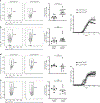Selective IL-27 production by intestinal regulatory T cells permits gut-specific regulation of TH17 cell immunity
- PMID: 37932457
- PMCID: PMC11058069
- DOI: 10.1038/s41590-023-01667-y
Selective IL-27 production by intestinal regulatory T cells permits gut-specific regulation of TH17 cell immunity
Abstract
Regulatory T cells (Treg cells) are instrumental in establishing immunological tolerance. However, the precise effector mechanisms by which Treg cells control a specific type of immune response in a given tissue remains unresolved. By simultaneously studying Treg cells from different tissue origins under systemic autoimmunity, in the present study we show that interleukin (IL)-27 is specifically produced by intestinal Treg cells to regulate helper T17 cell (TH17 cell) immunity. Selectively increased intestinal TH17 cell responses in mice with Treg cell-specific IL-27 ablation led to exacerbated intestinal inflammation and colitis-associated cancer, but also helped protect against enteric bacterial infection. Furthermore, single-cell transcriptomic analysis has identified a CD83+CD62Llo Treg cell subset that is distinct from previously characterized intestinal Treg cell populations as the main IL-27 producers. Collectively, our study uncovers a new Treg cell suppression mechanism crucial for controlling a specific type of immune response in a particular tissue and provides further mechanistic insights into tissue-specific Treg cell-mediated immune regulation.
© 2023. The Author(s), under exclusive licence to Springer Nature America, Inc.
Conflict of interest statement
L.-F.L. is a scientific advisor for Elixiron Immunotherapeutics and receives research grants from AstraZeneca, Avidity Biosciences and Molecular Axiom. E.I., J.B., M.N., M.C. and R.A.M are or were employees of AstraZeneca and may own stock or stock options. As such, they declare that they are bound by confidentiality agreements that prevent them from disclosing their competing interests in this work. The remaining authors declare no competing interests.
Figures














Update of
-
Selective IL-27 production by intestinal regulatory T cells permits gut-specific regulation of Th17 immunity.bioRxiv [Preprint]. 2023 Feb 21:2023.02.20.529261. doi: 10.1101/2023.02.20.529261. bioRxiv. 2023. Update in: Nat Immunol. 2023 Dec;24(12):2108-2120. doi: 10.1038/s41590-023-01667-y. PMID: 36865314 Free PMC article. Updated. Preprint.
References
MeSH terms
Substances
Grants and funding
- I01 BX005106/BX/BLRD VA/United States
- R01 AI108651/AI/NIAID NIH HHS/United States
- R01 AI126277/AI/NIAID NIH HHS/United States
- R56 AI127751/AI/NIAID NIH HHS/United States
- R00 DK110534/DK/NIDDK NIH HHS/United States
- F31 DK135162/DK/NIDDK NIH HHS/United States
- R37 AI126277/AI/NIAID NIH HHS/United States
- R21 AI163813/AI/NIAID NIH HHS/United States
- P01 AI132122/AI/NIAID NIH HHS/United States
- P30 DK120515/DK/NIDDK NIH HHS/United States
- R21 AI154644/AI/NIAID NIH HHS/United States
- K99 DK110534/DK/NIDDK NIH HHS/United States
- R01 AI145325/AI/NIAID NIH HHS/United States

